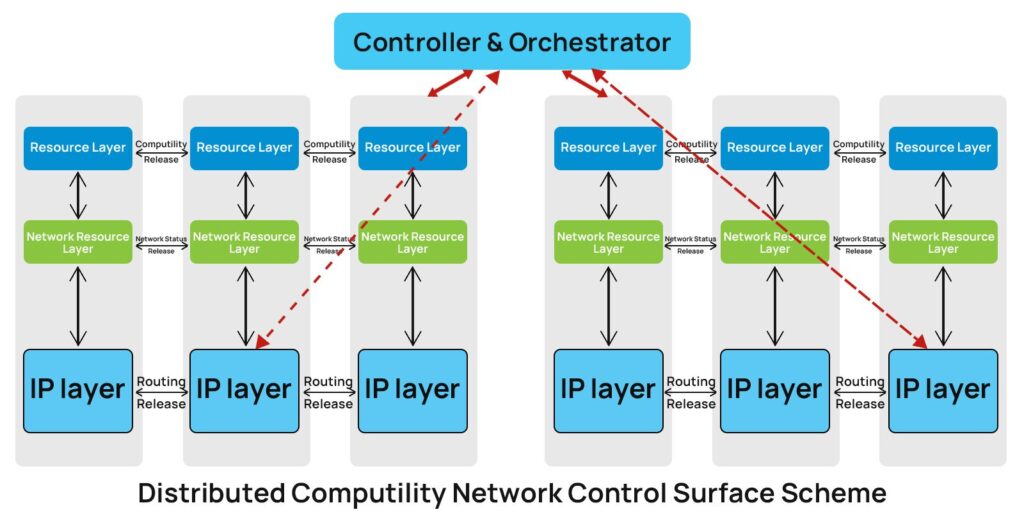Algorithm Network
In the 5G and post-5G era, in order to respond to the computing needs of services more quickly and efficiently, computing power resources are gradually sunk to the edge close to users, forming a new trend of heterogeneous and distributed computing power deployment.
with its mature and advanced connection-aware technology, the network infrastructure unifies multi-level distributed computing resources for dynamic nano-management, scheduling and orchestration. This realization of virtual computing resource pooling across the entire network brings advantages, while providing new service delivery capabilities and arithmetic network convergence business models for network operators while improving service quality and resource utilization.
The computational network, i.e., the network infrastructure with the sensing, scheduling and orchestration of computational resources, provides new ICT convergence services of network, computing and storage at the network layer. It represents a new generation of technology architecture and business operation system based on the network.
Arithmetic network control surface technology
In the arithmetic network system, the creation of arithmetic routing table requires dynamic sensing of distributed arithmetic, storage and other resource information. The sensing of this information and the corresponding creation of arithmetic routing table are key technologies in the arithmetic network control plane. The arithmetic network control plane can be divided into centralized, distributed and hybrid based on the different mechanisms used for collecting, scheduling and distributing arithmetic resources.
Centralized arithmetic network control surface solution
In the centralized arithmetic network control plane scheme, the arithmetic, storage and network resources, as well as node information of end, edge and cloud are collected and distributed in a unified manner by the centralized orchestrator . The centralized orchestrator arranges the optimal forwarding and routing paths according to the application requirements, taking account the state of arithmetic and network resources across the entire network, and sends them to the routing and forwarding nodes of the arithmetic network.
The arithmetic resources are distributed and deployed on the network infrastructure, such as edge computing nodes and cloud data centers. The arithmetic resource nodes interact with the centralized orchestrator (or controller) vertically in the north-south direction through the northbound interface.
Applications are accessed from edge nodes, and the centralized scheduler (or controller) needs to orchestrate routing policies based on awareness of the application and its computing power and network requirements. For typical applications, they can be pre-programmed and pre-configured by the centralized orchestrator and pre-delivered to the arithmetic network nodes. The ingress nodes map the applications to the pre-configured paths and route and forward the application traffic accordingly. For atypical applications, the arithmetic network ingress node (or arithmetic gateway) needs to notify the centralized scheduler through the signaling interface, and the latter will arrange and distribute the corresponding policies.

Distributed Arithmetic Network Control Surface Solution
In the distributed arithmetic network control plane scheme, resource nodes such as arithmetic and storage register (including updating and deleting) their arithmetic resource status information with the arithmetic network nodes nearby. The arithmetic network forwarding and routing edge nodes locally manage the arithmetic node resource information, and the local network-wide notification of arithmetic resource information is realized through distributed routing protocols (IGP & BGP).
The flooding notification of arithmetic resource information by routing protocols will construct a network-wide database of arithmetic resource states within a network domain (e.g., IGP) or between domains (e.g., BGP). This database serves as a reference for arithmetic network forwarding and routing devices to make routing and forwarding decisions based on arithmetic resource dimensions.

Hybrid Architecture Solutions
The centralized arithmetic network control surface scheme has the advantage of global resource view and has a minimal impact on devices and current protocols, but due to the large number of compute nodes and network nodes that require frequent interaction with the controller or orchestrator, the convergence speed is slow and inefficient, and it cannot adapt well to latency-sensitive arithmetic applications.
Distributed arithmetic network architecture can better solve the drawbacks of centralized architecture, but it involves significant adjustment of existing network equipment and existing protocols, which is costly and has a longer implementation cycle. Therefore, a hybrid architecture that combines both centralized and distributed interaction mechanisms can better balance the requirements of deployment cost and convergence speed in many application scenarios.

Arithmetic network forwarding surface and routing policy technology
In terms of routing mechanism, the arithmetic network is based on the current network routing mechanism with additional IT resource constraints such as computational power and storage. Therefore, the routing policy of arithmetic network must be orchestrated based on both network and arithmetic (including storage) constraints, and the encapsulation and decapsulation of data surface and traffic forwarding are performed accordingly. In the arithmetic network application forwarding scenario, resources such as arithmetic power and storage are often anchored by arithmetic functions or algorithms that can provide immediate service. In other words, the actual forwarding nodes for arithmetic application are the fundamental arithmetic functions or services.
